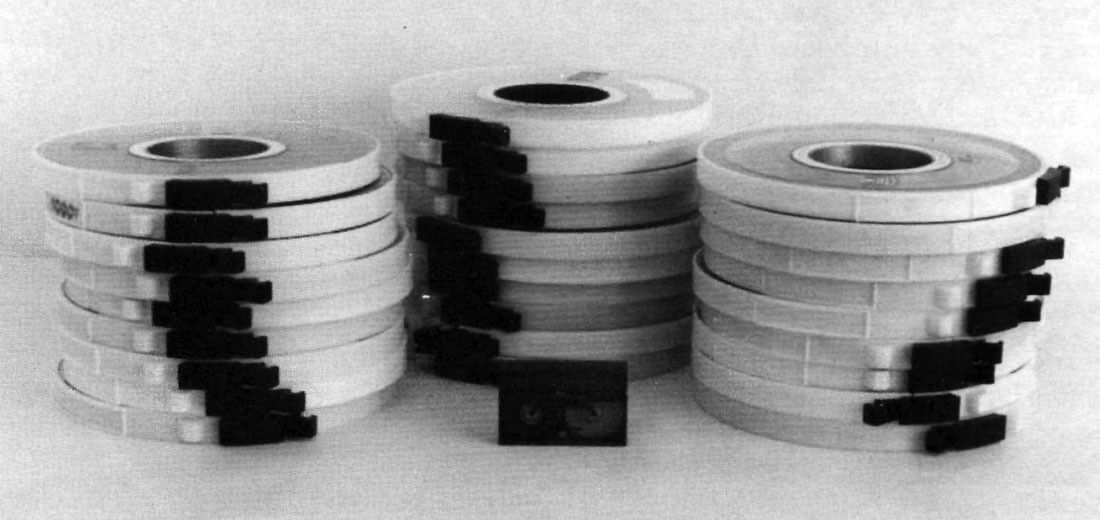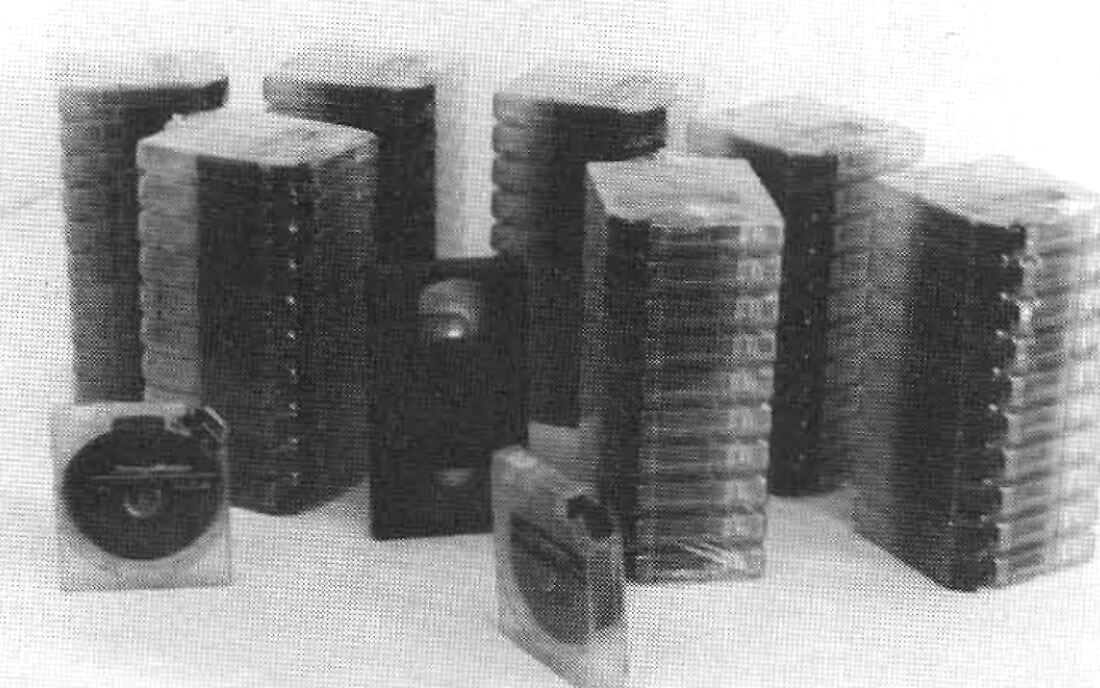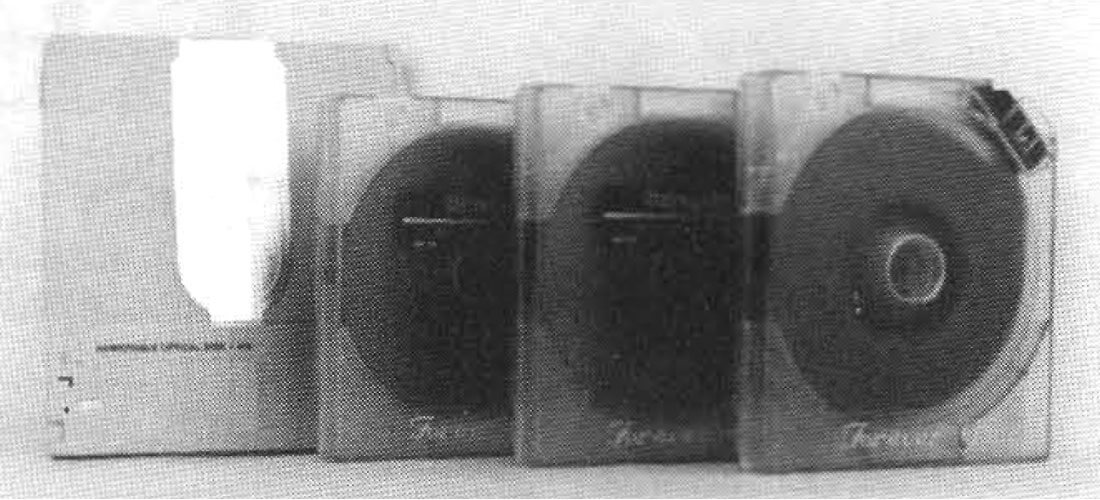At the November 1991 SEG Convention, Memorex Computer Supplies, a major manufacturer of magnetic tape; presented a white paper titled "Understanding Magnetic Tape Stiction and its Solutions" and reiterated this theme at a seminar held in Calgary on November 4, 1992. Other tape manufacturers currently distribute literature on the same subject. These documents describe a critical problem with pre-1987 manufactured magnetic tape, whereby the media is going through a worsening degenerative process.
Magnetic tape manufactured between 1981 and 1986 is particularly susceptible to this degradation process. The reason being that tape coatings were softened by most manufacturers during this period, in response to the need to extend the life of the soft metal read/write heads used at the time.
The binder formula implemented to soften the tape coating is deteriorating. The tape binder ingredient (polyester urethane) is combining with moisture in the air and breaking down, causing the oxide coating to separate from the mylar base. This hydrolysis process is accelerated in higher humidity and temperature environments.
The tape coating eventually softens to the point where a sticky debris results and collects on the read/write head and tape guides. When the drive comes to a stop, the tape can adhere to the head and guides, causing "stiction". Attempting to move the tape again will tear away the oxide coating.
Combined with high speed drives, the newer ceramic heads used today do not dissipate friction heat as effectively as the older chromium heads and are many times harder and rougher, making them much more abrasive to the media, thereby aggravating the problem.
Nothing can permanently halt this tape degradation process. Low humidity and cooler temperatures may slow the environmental deterioration somewhat, but will not stop it. These reels are currently in a "self destruct" process while sitting on the shelf.
Because of the dryer climate in Western Canada, the problem is not yet as severe in Calgary as it is in other parts of the world. But due to the volume of seismic data to be recovered and the time required to obtain budgets and process these reels, commitments on which data to archive must be made soon.
Output Media
Along with what data to rescue, a decision has to be made as to which output medium to use. There are multiple choices, each with their strengths and weaknesses. One of the considerations has to be compaction of this data on to fewer output media. For this reason, 9-track open reels will not be considered here.
For reference purposes, a 9-track 2400' open reel recorded at 6250 bpi has a data capacity of 180 megabytes. High speed drives (200 ips) can write to and read from this medium at a rate of approximately 1.3 megabytes per second, sustained. The medium's storage cost effectiveness is around seven cents per megabyte.
In practice, a "full" 2400' reel containing seismic information, recorded at 6250 bpi holds about 150 megabytes of data, due to inter-record gaps and file marks. Correspondingly, a 2400' reel recorded at 1600 bpi accommodates roughly 47 megabytes of data.
Some of the drives in the following list can not accept an "image copy" of seismic field data, without additional software manipulation to restore these records to their original form, as they appeared on the open reel. The alternative is to convert field formats to SEG-Y, should these peripherals be used. SEG-Y is a trace sequential (demultiplexed) format, where each trace becomes its own data block, whose size usually falls within constraints imposed by these peripherals.
NOTE: The risk in converting field formats to SEG-Y as the only archive (where the original data is no longer readable or destroyed) is that there is no recourse, should the conversion process eventually become suspect or subtly fail and go undetected. The potential to recover from gain application errors and/or scan errors is lost. Whenever possible, the original field format should be preserved.
These newer technologies have an intricate error correction code (ECC) mechanism, providing superior data integrity.
All of the following selected media have a life expectancy of twenty years and more. They can last much longer if cared for properly.
3480 and 3490E Cartridges
The cartridge is physically much smaller, but does not hold significantly more data than the open reel and does not approach the data capacities of other tape cartridge systems. Capacity of the 3480 and 3490 cartridge is 200 megabytes; the 3490E, with twice as many data tracks, can accommodate 400 megabytes. The medium is accepted as an industry standard.
The 3490 and 3490E systems use data compression algorithms, while the 3480 does not. Seismic data does not lend itself to data compression to any degree and little (if any) will be gained by using this technique
With appropriate drives and computer interfaces capable of sustaining data transfer rates, there is no restriction on record lengths and seismic field formats can be accommodated.
Sustained data transfer rates approach three megabytes per second. This is comparable to writing or reading a 2400' open reel from beginning to end, in sixty seconds.
Sustained data transfer rates are achieved in a "streaming mode", where many megabytes of data are sequentially transferred without interruption, during a given operation.
Media costs are less than those for open reels (one reel versus one cartridge). Hardware prices range from $25,000 (3480) to $65,000 (3490E) per drive. At three to four cents per megabyte, the medium's storage cost effectiveness is somewhat better than the open reel.
While waiting for a "standard" seismic data archival medium to emerge, many oil companies, especially in Europe and the United States, prefer this cartridge in the interim.
8mm (helical scan) Cartridge
This medium's packaging is considerably smaller than an open reel, but can hold 5,000 megabytes of data; equivalent to twenty-eight 2400' open reels.

Developed for the PC market as a disk backup device, this is the most widespread commercial mass storage device used today. Reportedly, no two drives track exactly alike, due to relatively lax mechanical specifications. Head wear is problematic.
Many computer industry experts believe this medium will begin to fade away within five years.
This device has an upper "block (data) size" limitation of 240 kilobytes, dictated by the ECC mechanism. To cope with most seismic field formats, each record must be partitioned into smaller segments, requiring special software to "block" and "de-block" the data, in order to preserve these records as contiguous entities as they appeared on the open reel. The alterative is to convert field data into a trace sequential format, such as SEG-Y, whose "block size" usually falls within the limitation.
Sustained data transfer rates, 0.3 to 0.5 megabytes per second, are lethargic for a magnetic tape vehicle. Three to five hours are required to write or read a complete error free cartridge.
A variation of this medium uses data compression techniques to achieve (under ideal conditions) a capacity of 25,000 megabytes and sustained data transfer rates of 2.5 megabytes per second. Seismic data does not lend itself to compression and very little would be gained using this scheme. These peripherals are not compatible with common 8mm systems.
Devices used to degauss open reels have little effect on this cartridge, due to the coercivity of its oxide coating, which makes the tape highly resistant to demagnetization and immune to print through or self erasure.
The medium's storage cost effectiveness is excellent at one fifth of a cent per megabyte. Hardware costs are reasonable; roughly $3,600 per drive, making this the most economical medium overall.
ST-120 (helical scan) Cartridge
This medium uses standard YHS packaging, but with digital grade tape. Data capacity is 14,500 megabytes; equivalent to eighty 2400' open reels. This peripheral emulates the 8mm system.

Sustained data transfer rates, up to two megabytes per second, are respectable. This is comparable to reading a 2400' open reel from beginning to end in ninety seconds. Two hours are required to read or write a complete cartridge in streaming mode.
In addition to helical tracks, the system has a longitudinal data track, which contains various positioning information, allowing for high speed searches. Average access to any location on the tape is sixty seconds.
This medium has an upper "block size" limitation of 256 kilobytes, dictated by the error correction code mechanism.
To cope with most seismic field for mats, each record must be divided into smaller units, requiring special software to "block" and "de-block" the data, in order to preserve these records as contiguous entities, as they appeared on the open reel. The alternative is to convert field data into a trace sequential (demultiplexed) format, such as SEG-Y, whose "block size" usually falls within the limitation.
Drive prices are in the $24,000+ range. Cartridge costs are three times those of open reels, but at three tenths of a cent per megabyte, its storage cost effectiveness is among the best.
Like other media with high coercivity oxide coatings, this tape is immune to print through or self erasure and highly resistant to demagnetization.
19mm (helical scan, D-2 format) Cartridge
Sizably larger than a YHS cartridge, this medium (also known as the DST 600 series) has a data capacity of 165,000 megabytes; equivalent to nine hundred and seventeen 2400' open reels. Smaller cartridge capacities of 25,000 and 75,000 megabytes are also available. All cartridge sizes use the same drive.
The 165,000 megabyte cartridge can accommodate roughly one thousand one hundred 2400' (6250 bpi) reels of seismic information or, if recorded at 1600 bpi, in excess of three thousand five hundred 2400' reels.
The drive can sustain data transfer rates of fifteen megabytes per second, akin to reading or writing a complete 2400' reel in twelve seconds.
Using a separate longitudinal track for positional information, search speeds are more than fifty times the read/write rate; comparable to scanning through four 2400' reels per second.
The error correction code "blocking" mechanism is transparent to the user, allowing "image copy" of seismic field formats.
Like other media with high coercivity oxide coatings, the tape is highly resistant to demagnetization and immune to print through or self erasure.
Drives sell for $200,000+ but the medium's storage cost effectiveness, at one tenth of a cent per megabyte, is presently unsurpassed.
The format has been submitted to the American National Standards Institute, with endorsement expected by mid-1994.
The DST 600 drive is manufactured by Ampex Corporation. When repackaged by E-Systems for their EMASS library system, this same drive is designated the model ER90.
The SEG is in the process of establishing a standard for this medium, which is based on the RP66 standard from API. A group of European and United States oil companies are presently evaluating this medium for archival of seismic data. Several have already committed to this technology.
12" Optical (WORM) Disk
The medium's packaging is physically larger than open reels, but holds 6,800 megabytes of information; equivalent to thirty-eight 2400' open reels (19 reels on each side of the platter).
This medium's principal advantage over magnetic tape systems is its ability to access data at random, making it ideally suited to document imaging applications.
When used for archiving seismic field information, this medium's random access benefit is effectually nullified, as this data is invariably written and retrieved sequentially.
Industry standards do not exist for these disks; data written on one manufacturer's drive can not be read by another's and none conform to any ANSI standard format.
While reading, sustained data transfer rates, from 0.5 to 0.9 megabytes per second (for the newest drives), are substantially slower than for other archiving vehicles and not much better than the common 8mm medium.
Write/verify data rates are nominally half the read rate, making this operation slower than for the 8mm system.
Drives sell for $23,000+ and at approximately five to six cents per megabyte, this disk is the least cost effective seismic archival medium. The 5.25" optical disk's storage cost effectiveness is considerably less, at over nine cents per megabyte.
Optical Tape
Resembling an oversized reel of magnetic tape, this medium is 35 millimeters wide and up to 830 meters long. Data capacity is in the terabyte realm; equivalent to more than five thousand five hundred 2400' open reels.

In practice, approximately 6,700 reels (2400' at 6250 bpi) would be required to hold one terabyte of seismic data. At 1600 bpi, roughly 21,000 reels would be needed.
Sustained data transfer rates, up to three megabytes per second, are good (four to ten times faster than the optical disk) and within the abilities of common computer peripheral interfaces.
This drive has superior data error correction capabilities. Although data is internally "blocked" by this mechanism, the process is transparent to the user and the medium will accommodate "image copy" of seismic field formats.
In addition to normal data tracks, the drive has a separate address track, allowing for high speed searches. Average access to any location on the tape is twenty-eight seconds. To search from one end of the media to the other takes no more than sixty seconds. This time is comparable to searching through one hundred and fifty 12" optical disks, scanning three disks every second.
Although drives cost $250,000 each, the medium' s storage cost effectiveness is acceptable, at one cent per megabyte.
If magnetic tape systems are not an option, this could be the alternate seismic field data archiving medium for large libraries and is currently implemented on and contemplated for several sites outside of Canada.
Government and Space agencies are the predominant users of this Canadian technology.
| Comparative Media Costs to Archive 720,000 Megabytes (Equivalent to Four Thousand 2400' Reels) | |||
|---|---|---|---|
| Media | Media cost | Read time | # req'd |
| *more than 700 hours to write Read time is the actual time required to read 720,000 megabytes of information under ideal error free conditions, providing data transfer rates can be sustained. It does not include load or stop times. # req'd is the number of cartridges, reels or disks required to hold 720,000 megabytes of data. |
|||
| 19mm, D-2 Cartridge | $720.00 | 13 hours | 5 |
| 8mm Cartridge | $1,440.00 | 500 hours | 144 |
| ST-120 Cartridge | $2,160.00 | 100 hours | 50 |
| Optical Tape | $7,200.00 | 66 hours | 1 |
| 3490E Cartridge | $21,600.00 | 66 hours | 1800 |
| 3480 Cartridge | $28,800.00 | 66 hours | 3600 |
| 12" Optical Disk | $38,000.00 | 400 hours* | 106 |
| 5.25" Optical Disk | $80,000.00 | 400 hours* | 1108 |











Join the Conversation
Interested in starting, or contributing to a conversation about an article or issue of the RECORDER? Join our CSEG LinkedIn Group.
Share This Article